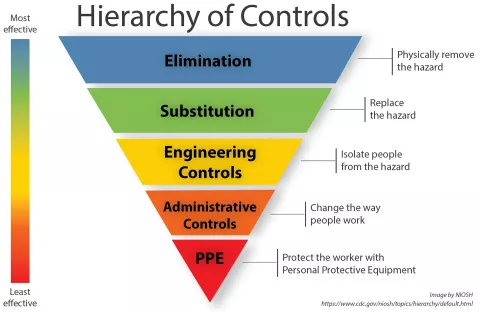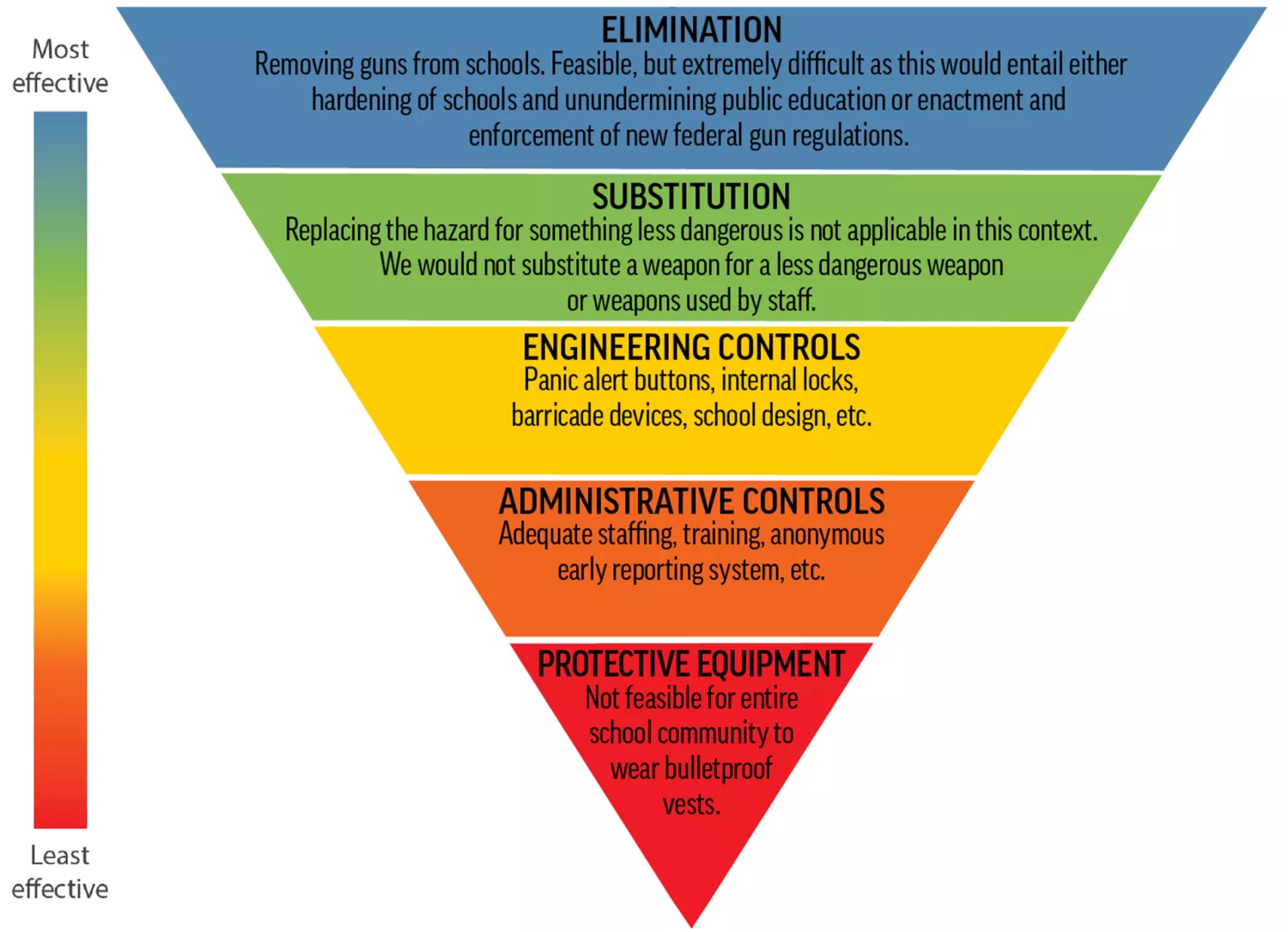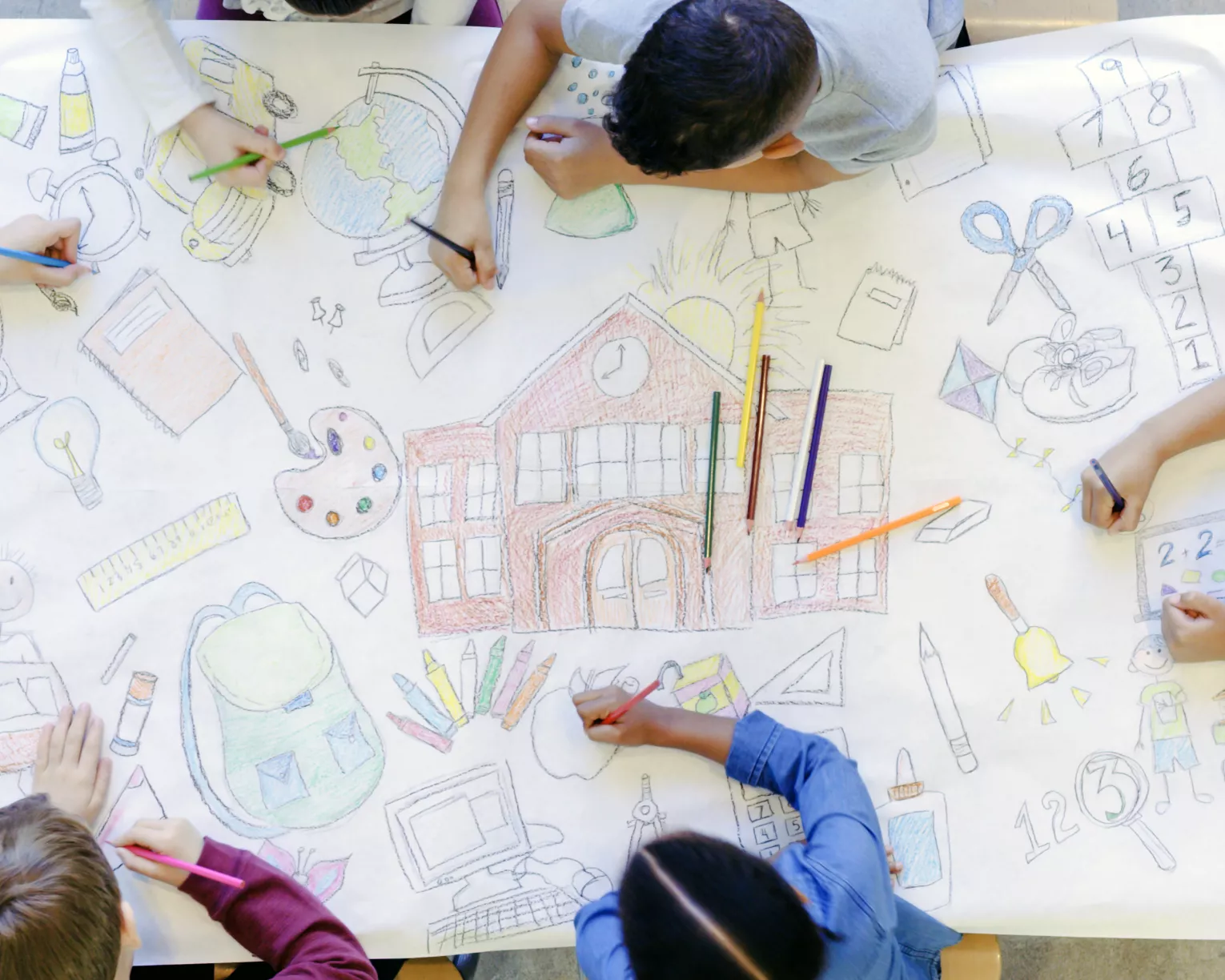Schools should be among the safest places in every community, but school-related threats and violence, including gun violence, constitute a growing concern for students, educators, and members of the community. To help address this worsening public health crisis, employers and educators can implement the hierarchy of controls—a proven approach to minimizing or eliminating exposure to workplace hazards—to sensibly prevent gun violence in schools.

The hierarchy of controls, which is often applied to address hazards like infectious diseases and mold, identifies five broad steps “as a means of determining how to implement feasible and effective control solutions,” according to the National Institute for Occupational Safety and Health, part. of the Centers for Disease Control and Prevention. The basic concept relies on applying the most effective steps first. As demonstrated in Figure 1, the hierarchy of controls, in order of effectiveness, is as follows:
- Elimination of the hazard (physically removing it);
- Substitution of the hazard (replacing the hazard);
- Engineering controls (isolating people from the hazard);
- Administrative controls (changing the way work is organized and how people do their work to minimize the hazard); and
- Personal protective equipment (providing physical equipment to protect people when they do their work).
In the context of gun violence, the best strategy is for school districts to implement a multilayered array of controls to counter the hazard, focusing on the application of the most effective measures first and avoiding those that undermine education. When necessary, school districts can use multiple layers of controls to mitigate violence when a single layer may be less effective. The measures adopted to address the hazard should not undermine the very purpose of that work. In public education, that means gun violence controls cannot undermine culturally competent, trauma-informed education or rely on “hardening” approaches. School hardening generally involves attempts to fortify schools against gun violence through their physical design and additional security measures.
Figure 2 provides examples of gun violence prevention in the hierarchy of controls structure. See Table 1 for a list of controls that can be implemented to curb gun violence in schools without undermining safe, just, and equitable schools. In joint labor-management health and safety committees, educators can establish a process for local associations to receive and respond to reports of hazards and advocate for effective, feasible controls. Moreover, in bargaining or other meet-and-confer discussions, the parties can come to an agreement on other issues related to violence, such as supports following an act of gun violence. School districts can implement effective, feasible controls that include panic alert buttons, a limited number of entry points, the creation of violence prevention health and safety committees, and the implementation of an anonymous early reporting system for students who may witness threatening or troubling statements or behaviors. The Sandy Hook Promise Say Something Anonymous Reporting System has confirmed more than 600 lives saved and assistance provided to more than 5,000 students during mental health crises.

Table 1a. Gun Violence Prevention: Engineering Controls
| Supported | Opposed |
|---|---|
| Implement prevention through design. | Contruct prison-like school environments. |
| Install gates at campus entrances and exits. | Install surveillance technology. |
| Install internal door locks. | |
| Install lockless student lockers/removal of student lockers. | |
| Limit and monitor entry to the school. | |
| Provide panic alerts. | |
| Provide sufficient outdoor lighting. |
Table 1b. Gun Violence Prevention: Administrative Controls
| Supported | Opposed |
|---|---|
| Create a positive school climate, including restorative practices and support for social and emotional competencies. | Apply behavioral threat assessment programs and approaches that disproportionately target Native students and students of color. |
| Create an anonymous/confidential early reporting procedure for studentsand staff. Ensure it is safe to speak up. | Use federal funds to harden schools. |
| Create smaller class sizes. | Deploy armed school resource officers (SRO)/sworn law enforcement officers. |
| Decrease overreliance by educators on referrals to law enforcement. | |
| Develop and engage in authentic, broad partnerships with parents and community groups. | |
| Ensure emergency planning and other responses are trauma-informed. | |
| Establish district-wide and school-based crisis response teams and responses. | |
| Establish methods to identify students with serious violence-related potential and create appropriate ways to inform educators. | |
| Establish visitor sign-in and name badge rules. | |
| Exclude from school students who bring guns or other deadly weapons to school until completion of a mandatory prescribed intervention. | |
| Hire more specialized instructional support personnel (SISP), such as social workers, nurses, and mental health professionals. | |
| Implement clear backpack policies. | |
| Practice student drills that are mindfully conducted to minimize student and staff trauma as much as possible. | |
| Provide mental health services in schools and/or connect students with community resources. | |
| Review and update violence-related policies and procedures to ensure physical and mental health and safety of individuals in the school environment. | |
| Set clear and nondiscriminatory disciplinary codes and establish disciplinary policies that do not criminalize students’ behaviors. | |
| Train staff in restorative justice, de-escalation tactics, racial justice, cultural competency, crisis intervention practices, and anti-bias. |
Unproven approaches, like hardening schools, overlook clear evidence that these approaches fail to reduce gunfire incidents. School security staffing has steadily increased, but the number of gun violence incidents in schools has not gone down, providing further evidence that hardening policies do not have the intended effect of keeping students and educators safe from gun violence. Other measures that have similar hardening effects are locker checks/random searches, metal detectors, practices that overuse suspension and expulsion, and zero-tolerance discipline policies.
School districts can use the hierarchy of controls as a useful frame for considering which gun violence prevention measures are best to implement; however, determining how to implement them requires additional planning and work. In states with Occupational Safety and Health Administration (OSHA)-approved state plans, the responsibility falls on the employers, including public schools and institutions of higher education, to furnish a place of employment that is free of recognized hazards. OSHA published Guidelines for Preventing Workplace Violence for Healthcare and Social Assistance Workers, which identifies controls that employers can implement to prevent workplace violence. Employers can apply many of the workplace violence controls to mitigate gun violence as well. The OSHA guidance provides the following framework to effectively implement workplace violence controls:
- Identify and evaluate the extent of the hazard;
- Select effective and feasible controls to eliminate or reduce hazards;
- Implement these controls in the workplace;
- Follow up to confirm that these controls are being used and maintained properly;
- Evaluate the effectiveness of controls and improve, expand, or update them as needed.
LITERATURE REVIEW OF APPROACHES TO MINIMIZING GUN VIOLENCE IN SCHOOLS
School districts can implement engineering controls to remove the hazard from the workplace or create a barrier between the worker and the hazard. Examples of engineering controls include panic alert buttons, limited entry points, and better lighting. An analysis of previous gun violence incidents at Sandy Hook Elementary School and Marjory Stoneman Douglas High School determined that the lack of internal door locks on classroom doors exposed educators and students to danger. The Sandy Hook Advisory Commission agreed that schools should ensure that classroom doors lock from the inside as well as the outside, and the ability to control access should be a component of every school security plan (Sandy Hook Advisory Commission, 2015). Controlling access to school buildings has become a relatively common practice. A U.S. Department of Education report found that regarding limiting access, 85 percent of principals reported locking or monitoring doors to the school building during the day (U.S. Department of Education, 2007b).
Many schools have implemented physical safety practices, such as metal detectors and security cameras. However, it is important to note that under-resourced schools are more likely to utilize such practices in place of more intensive responses, such as counselors or mental health services, due to costs (Zimmerman and Astor, 2021). Recent findings show that security measures in the absence of other positive school climate initiatives may send a message to students that the campus is not safe, potentially having a negative impact on school climate and student morale (Addington, 2014; Johnson et al., 2018). An older study found no clear evidence that measures, such as security cameras or guards, are effective in preventing school violence (Addington, 2009).
Administrative controls change the way work is organized and how people do their work to minimize the hazard. A positive workplace assists individuals to perform in an efficient manner with reduced stress. A positive school climate includes implementing restorative practices and engaging social-emotional competencies. Additionally, a thorough review of controls is necessary to gauge whether or not they are helpful or harmful to the school environment.
The School Climate Bullying Survey (Klein, Cornell, and Konold, 2012) and the Youth Risk Behavior Surveillance Survey (Centers for Disease Control and Prevention, 2010) found that positive school climate was associated with lower student risk behavior. Educators can work toward developing a positive school climate, which is associated with reduced aggression and violence (Brookmeyer, Fanti, and Henrich, 2006; Goldstein, Young and Boyd, 2008; Gregory et al., 2010), reduced bullying behavior (Birkett et al., 2009; Kosciw and Elizabeth, 2006; Meraviglia, Becker, Meyer-Adams and Conner, 2008; Yoneyama and Rigby, 2006), and reduced sexual harassment, regardless of sexual orientation (Attar-Schwartz, 2009). Positive school climate is associated with stronger socialemotional competence, risk prevention, and improved development (Konold et al., 2018; Osher and Berg, 2017; Thapa et al., 2013; Wang, and Degol, 2016). Educators are encouraged to utilize and implement social-emotional learning practices, which have been shown to significantly improve social and emotional skills, attitudes, behavior, and academic performance (Durlak, Weissberg, Dymnicki, Taylor, and Schellinger, 2011).
Restorative practices are rooted in creating and mending relationships instead of using the sole approach of punishment. Through this process, the students have a chance to take control of the narrative and express their own needs through conflict resolution (Katic et al., 2020). Restorative practices instill empathy and understanding, and they empower all parties to move toward a process of healing (Gregory et al., 2016; Song et al., 2020). Educators can use this to serve as a nonpunitive, relationship-centered approach to proactively avoid harm and mend harmful situations (Gregory et al., 2016).
Administrators and schools can also implement another important approach, addressing diversity and equity head-on. All staff, teachers, and paraprofessionals must participate in continual diversity, equity, and inclusion (DEI) training to address topics such as implicit bias, cultural humility, and trauma-informed care for a school-wide cultural change to occur (Espelage, Robinson, and Woolweaver, 2023).
It is important for districts to set clear, nondiscriminatory disciplinary codes and codes that do not criminalize students. Punitive and exclusionary school discipline policies, like zero tolerance, often over-criminalize students of color, and they do not ensure school safety. Administration can replace zero tolerance with restorative practices, threat assessments, and positive school relationships (Price and Khubchandani, 2019). Policies and practices that push our nation’s students—especially our most at-risk students—out of the classroom and into the juvenile and criminal justice systems. This pipeline reflects the prioritization of incarceration over education.
Regarding emergency and violent situations, there are several possible controls. First, the foundation of an emergency response must be trauma-informed. The root of the process has to acknowledge the significance of trauma, recognize the signs of traumatic exposures, and respond mindfully so as to not re-traumatize the individuals in the situation (Overstreet and Chafouleas, 2016). Students and educators also must feel encouraged and safe to report suspicious situations or threats. Schools should educate students on how to inform an adult when they learn of a peer threatening firearm violence (Price and Khubchandani, 2019). A study by the U.S. Secret Service indicates that from 2008 to 2017, at least one person knew about an attacker’s plan 77 percent of the time (U.S. Department of Homeland Security, 2019). Every step of a school safety plan must be solidified, including visitor sign-in and badge requirements. According to the U.S. Department of Education, 48 percent of schools require identification cards or badges for faculty (U.S. Department of Education, 2007).
Hiring SROs, or school resource officers, on campus is another administrative control for school safety; however, SROs have not been found to directly reduce school gun violence. A study examined 179 shootings on school grounds from 1999 to 2018 and found no evidence in support of SROs reducing death or injury in this situation (Livingston, Rossheim, and Stidham, 2019). While there is a study that shows SROs may reduce school fights, they do not prevent gun-related incidents. The National Institute of Justice funded a study of every school shooting, or attempt, from 1998 to 2019. It found that the death rate in these incidents was 2.83 times higher in schools with armed guards than in those without (Peterson et al., 2021).
In fact, research shows that disciplinary actions—including suspensions, expulsions, arrests, and police referrals—increase when police are in schools (Sorensen et al., 2023). A 2015–2016 U.S. Department of Education report showed that having police in schools was associated with 3.5 times more arrests in schools with police (Whitaker et al., 2019). Overall, there are mixed outcomes in relation to the use of school security or school resource officers. There are findings showing a decrease in serious crime (Jennings et al., 2011; Sorenson et al., 2020), an increase in incidents of crime (Devlin and Gottfredson, 2018; Gottfredson et al., 2020; Na and Gottfredson, 2013), and decreased school connectedness (Theriot, 2016).
There are also concerns of SROs’ effectiveness in relation to the racial justice movement. Due to this, police involvement in schools is in question as well. According to research, students of color have less benefits and less acceptance toward police in schools, which potentially is due to trauma from over-policing in their communities (Advancement Project 2018; Pentek and Eisenberg 2018; Theriot and Orme 2016). Police presence also causes Black and Brown students to have higher rates of mental health issues, stress, anxiety, and fear as well as lower academic performance (Nayeb and Meek, 2020).
Lastly, in the case of school shooter drills, there is essentially no research validating the utility of school shooter drills that involve students (Jonson, 2017). There is more evidence proving their presence can harm the school community. Additionally, they can lead to alarming increases in anxiety, depression, stress, and fear of death in students and educators (El Sherief et al., 2021).
Are you an affiliate?

